
INDIANA—Just ahead of Organization Day at the Indiana General Assembly, the Indiana Chamber of Commerce has unveiled the advocacy element of its tax research, which is designed to inform state lawmakers’ decision-making on potential changes to Indiana’s tax structure.
Conducted by Ernst & Young LLP for the Indiana Chamber Foundation, phase two of the tax study is entitled “Indiana’s Tax System: Actions to Drive Future Prosperity.” It examines the potential revenue effects of various changes to Indiana’s state and local tax system, presenting policymakers with actionable data to support the state’s economic growth and competitiveness.

“Providing policymakers with data-driven insights is central to the Indiana Chamber’s mission of fostering a strong business environment,” says Vanessa Green Sinders, president and CEO of the Indiana Chamber. “This analysis examines potential scenarios to help legislators evaluate the impacts of different reforms before the legislative session. By taking this proactive, informed approach, we aim to ensure Indiana’s tax policies remain competitive and supportive of long-term growth.”
Phase two builds on the findings of phase one, which highlighted Indiana’s strong overall tax competitiveness but also pinpointed challenges in key industries. The latest analysis offers recommendations to update Indiana’s property tax system, targeting the tax burden on manufacturing and life sciences – two industries essential to the state’s economic success.
Currently, businesses pay personal property taxes on equipment and other assets. These assets are classified based on their expected life into “pools,” each with its depreciation schedule and individual floor. Additionally, an aggregate floor requires that the total taxable value of all property cannot drop below 30% of its original acquisition cost, regardless of depreciation. This complex system creates significant compliance challenges for business owners.
Indiana businesses currently pay approximately $1.5 billion annually in business personal property taxes, representing about 15% of total property tax collections statewide. This tax is a significant burden for capital-intensive industries like manufacturing and life sciences, which face higher effective rates than other sectors.
The phase two analysis evaluates potential reforms, including exempting newly acquired equipment from taxation and eliminating depreciation floors requiring minimum taxable property values. These reforms are designed to enhance Indiana’s competitiveness, particularly for industries vital to the state’s economy, while also recognizing the importance of maintaining revenue stability for local governments.
Exempting newly acquired business equipment from taxation would phase out $1.5 billion annually in business personal property tax revenue over time. This reform would reduce the cost of capital for businesses by 4.85%, encouraging investment in new equipment and modernization. The policy change is estimated to add $3.1 billion to state gross domestic product (GDP).
Eliminating depreciation floors would reduce annual business personal property tax revenue by $45 million. This reform would lower taxable values, easing the burden on capital-intensive industries. The projected macroeconomic benefits include an $80 million annual increase in GDP, further enhancing Indiana’s competitiveness.
The study also evaluates other potential policy changes, including reforms to the maximum levy growth quotient, adjustments to local option income taxes, and alternative approaches to taxing business pass-through income. These options were designed to balance revenue needs with economic growth, providing legislators with a comprehensive view of how each reform could impact Indiana’s fiscal health and economic competitiveness.

“Indiana’s competitive tax climate is the result of deliberate, forward-looking policies,” offers David Ober, Indiana Chamber senior vice president of business operations and finance. “However, our property tax system continues to create challenges for industries vital to our economy. These proposed reforms present an opportunity to reduce barriers for these sectors while maintaining our state’s reputation as a leader in business-friendly policies.”
The Indiana Chamber believes part two of the research provides a foundation for discussions between state and local leaders as they explore ways to modernize Indiana’s tax system.
“These findings mark the next phase of an important dialogue,” Sinders states. “We look forward to collaborating with policymakers, local governments, and other stakeholders to craft reforms that position Indiana for long-term economic success.”
The tax study was informed by consultations with the Indiana Chamber Tax Research Advisory Committee, which is comprised of representatives from key business sectors, tax policy experts, consultants, relevant state agencies, and economic development professionals.
Ambassador Enterprises and AES Indiana are the lead investors in this two-phase tax study. Other key contributors are Maple Leaf Farms and BP America, along with support from Dormakaba Americas, Cleveland-Cliffs Inc., Al and Kathy Hubbard, and CountryMark.
View the full Indiana Chamber Foundation study at www.indianachamber.com/tax.



